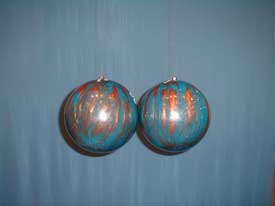Demos: 1N-02 Collision of Two Large Balls

This demonstration illustrates what happens in both elastic and inelastic collisions. It shows the necessity for applying, in the elastic case, two conservation laws--momentum and mechanical energy. Two large bowling balls are suspended by wires. If one is pulled back a few inches and released, it will collide with the other, causing the first ball to stop and the second to move off with the identical speed the first one had just prior to the collision. By placing a piece of clay on one ball, the two will stick upon colliding and the two go off together at half speed.
Directions: When pulling the ball back, be careful to keep the alignments so that the collision occurs along a line connecting their two centers. In addition to the two scenarios above, you might pull each ball back the same distance and let them collide head on. If the clay is attached, the balls will stop dead in their tracks.
Suggestions for Presentation: Ask whether applying the conservation of momentum to the elastic collision can uniquely predict what the final velocities will be. If the masses are identical, we have, for the conservation of momentum (one mass at rest initially):
which means that the final speeds could be any combination that add up to v1.
We know that for elastic collisions, the relative velocity before the collision is equal to the negative of the relative velocity after the collision:
The only way these two equations can be satisfied simultaneously is if
which means the first ball stops and the second ball moves off with the same velocity the first ball had prior to the collision.
Ask the students if they can think of a single word that proves the collisions are not perfectly elastic. (The word is CLICK. Because you can hear the sound of the collision, some energy had to go into producing that sound!)
Applications: The basic principles here can be applied to the Fun Balls Demo (1N - 12)
Last Updated: Nov 30, 2023 11:25 AM